The Kern Valley is known for beauty, sunny skies, and clean air, as well as prime fishing in Lake Isabella and the Kern River. The Valley played a significant role in
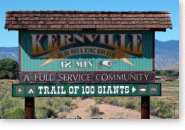 California's history, and in modern times has served as a major film location site, especially for Westerns of the 1930s, 1940s, and 1950s.
California's history, and in modern times has served as a major film location site, especially for Westerns of the 1930s, 1940s, and 1950s.
The history of Kern Valley dates back to 1,000 B.C. when it was inhabited by the Tubatulabal and Kawhsu Indians. Their occupation is evidenced by petroglyphs and grinding holes found on the rocks throughout the valley. Related to the Shoshone, many descendants of these Native Americans continue to live in the valley, especially in the south fork area, and are still guided by their ancient customs and wisdom.
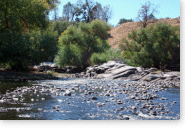 Early Spanish missionaries in the late 1700s probably had some direct contact with these Native Americans; however, the first documented non-Indian traveler who entered the Kern Valley was Captain Joseph Reddeford Walker. En route to the Owens Valley, Walker had been looking for the northernmost pass through the Sierra Nevada Mountains that was also comparatively snow-free. After crossing the Southern Sierra, he came from the east along the South Fork of the Kern River and entered the Kern Valley in May 1834. The 5,200-feet elevation pass that he came over was named Walker Pass in his
Early Spanish missionaries in the late 1700s probably had some direct contact with these Native Americans; however, the first documented non-Indian traveler who entered the Kern Valley was Captain Joseph Reddeford Walker. En route to the Owens Valley, Walker had been looking for the northernmost pass through the Sierra Nevada Mountains that was also comparatively snow-free. After crossing the Southern Sierra, he came from the east along the South Fork of the Kern River and entered the Kern Valley in May 1834. The 5,200-feet elevation pass that he came over was named Walker Pass in his
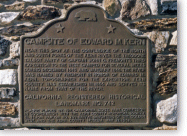 honor. In 1843, Capt. Walker made several trips through the Kern Valley as he guided wagon trains of emigrants from Missouri to California, through Owens Valley and west over Walker Pass on their way to the coast.
honor. In 1843, Capt. Walker made several trips through the Kern Valley as he guided wagon trains of emigrants from Missouri to California, through Owens Valley and west over Walker Pass on their way to the coast.
In the winter of 1845-1846, the Theodore Talbot party of Capt. John C. Frémont's third expedition to the West camped for several weeks at the confluence of the north and south forks of the Kern River, a location which today is deep under the waters of Lake Isabella. Frémont named the river in honor of Edward M. Kern, the expedition's topographer. The Kern River is the third longest river in California, flowing approximately 164 miles from a high plateau west of Mount Whitney to Lake Buena Vista southwest of Bakersfield. The Upper Kern (the portion that flows into Lake Isabella) is reported to be one of the best trout streams in California. The Lower Kern (the portion that flows out of Lake Isabella) is the steepest river west of the Mississippi. In some stretches, the narrow and comparatively shallow Kern River descends 75 feet in the course of a mile. The first European known to have twice crossed the Kern River, near the mouth of the canyon, was Padre Francisco Garces,
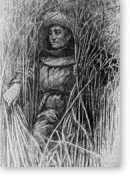 a Spaniard from Aragon. Accompanied by two Mojave Indian guides, Garces arrived at a Yokuts Village on May 1, 1776, where he reported seeing a great, rushing river whose waters were crystalline, bountiful, and palatable. He named it Rio de San Felipe. Thirty years later, Father Jose Zalvidea named it La Porciuncula. The Mexicans called both the river and the mining district at the mouth of the canyon Rio Bravo. In 1848, with the signing of the Treaty of Guadalupe Hidalgo to end the Mexican War, Alta California and the whole southwest territories were ceded to the United States government by Mexico. As a result, the United States territories stretched from sea to shining sea.
a Spaniard from Aragon. Accompanied by two Mojave Indian guides, Garces arrived at a Yokuts Village on May 1, 1776, where he reported seeing a great, rushing river whose waters were crystalline, bountiful, and palatable. He named it Rio de San Felipe. Thirty years later, Father Jose Zalvidea named it La Porciuncula. The Mexicans called both the river and the mining district at the mouth of the canyon Rio Bravo. In 1848, with the signing of the Treaty of Guadalupe Hidalgo to end the Mexican War, Alta California and the whole southwest territories were ceded to the United States government by Mexico. As a result, the United States territories stretched from sea to shining sea.
With the discovery of gold at Sutter's Mill in 1848, gold-seekers flooded Northern California, and many of them used the Kern Valley route to pass through the Sierras on their way to the northern gold fields. In 1853, gold-miner Richard M. Keyes discovered gold in a quartz vein a few miles from the present-day community of Lake Isabella. The town of Keyesville sprang up overnight. Over the next few years, many would-be millionaires anticipating the next big gold strike swarmed the area. In 1858, a Cherokee named Lovely Rogers was chasing his mule in the area where Wofford Heights is today, and paused to pick up a rock to throw at the running animal. The rock glimmered with gold flecks.
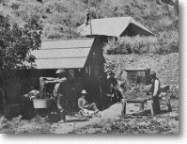 Reminiscent of Keyesville, soon Rogersville sprang up adjacent to the newfound Big Blue mine. Legend has it that an enterprising individual threw a plank across two barrels and opened a whiskey bar, which prompted the gold mining camp to be renamed Whiskey Flat. A few years later in 1864, the people of the now growing town changed its name to the more respectable
Kernville, in honor of Edward Kern. That same year, the discovery of gold in Havilah, just south of Kern Valley, set off yet another gold rush. Havilah rapidly grew to 3,000 residents. Stagecoaches and freight wagons traveled the Kern Valley's dusty trails, going to and from the gold fields. In 1866, portions of Tulare and Los Angeles Counties were split off to form Kern and Inyo Counties, and on April 2, Havilah became the Kern county seat. Havilah was the largest town in the county and published its own newspaper.
Reminiscent of Keyesville, soon Rogersville sprang up adjacent to the newfound Big Blue mine. Legend has it that an enterprising individual threw a plank across two barrels and opened a whiskey bar, which prompted the gold mining camp to be renamed Whiskey Flat. A few years later in 1864, the people of the now growing town changed its name to the more respectable
Kernville, in honor of Edward Kern. That same year, the discovery of gold in Havilah, just south of Kern Valley, set off yet another gold rush. Havilah rapidly grew to 3,000 residents. Stagecoaches and freight wagons traveled the Kern Valley's dusty trails, going to and from the gold fields. In 1866, portions of Tulare and Los Angeles Counties were split off to form Kern and Inyo Counties, and on April 2, Havilah became the Kern county seat. Havilah was the largest town in the county and published its own newspaper.
As the supply of gold gradually declined, local area residents turned to ranching for their livelihood. By the late 19th and early 20th centuries, ranching was the main occupation in Kern Valley. In the late 1800s, land parcels were laid out, ranchers established homesteads, schools, and churches, and townships such as Bodfish and Isabella were established.
In 1869, Bakersfield was founded with the opening of a post office. It soon had a thriving newspaper. In February 1873, Bakersfield became incorporated and the county seat was moved there from Havilah. As these communities continued to grow, the Kern River was soon harnessed for hydroelectric power, and in 1890 the river's first hydroelectric operation (owned by
PG&E) was completed. During the early 1900s, additional hydroelectric power plants were built along the Kern to supply electricity for other growing cities. A much needed road connecting these power projects was built in portions over several years and finally completed in 1926.
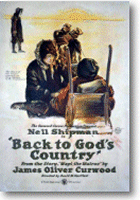 Kernville is located in Kern County between Bakersfield and Ridgecrest, nestled in the foothills of the Greenhorn Mountain Range at the southern base of the Sierra Nevada Mountains. The Kern River Valley and the Sequoia National Forest are less than three hours from Hollywood and offer spectacular diversity that ranges from arid deserts to verdant mountains, from remote streams to formidable rivers and lakes, from deep canyons to lush meadows and giant sequoia forests, and from winding mountain roads to dusty hiking trails.
Kernville is located in Kern County between Bakersfield and Ridgecrest, nestled in the foothills of the Greenhorn Mountain Range at the southern base of the Sierra Nevada Mountains. The Kern River Valley and the Sequoia National Forest are less than three hours from Hollywood and offer spectacular diversity that ranges from arid deserts to verdant mountains, from remote streams to formidable rivers and lakes, from deep canyons to lush meadows and giant sequoia forests, and from winding mountain roads to dusty hiking trails.
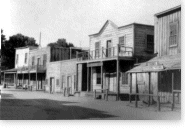 Consequently, since 1916 both areas have been desirable on-location sites for filmmakers. One of the earliest movies to be filmed in Kernville was Back to God's Country (1919) starring Nell Shipman. With the rising popularity of Westerns in the 1920s, Hollywood production companies began filming in the Kern Valley with ever-increasing frequency. In the 1920s, Kernville became the location of several silent Westerns including Branded a Bandit (1924), White Thunder (1925), and Wild Horse Canyon (1925) all of which starred Yakima Canutt, who would become one of Hollywood's most renowned stuntmen and second unit directors. Soon, Kernville's film activity increased to the point that the town built a special Movie Street with false fronts.
Consequently, since 1916 both areas have been desirable on-location sites for filmmakers. One of the earliest movies to be filmed in Kernville was Back to God's Country (1919) starring Nell Shipman. With the rising popularity of Westerns in the 1920s, Hollywood production companies began filming in the Kern Valley with ever-increasing frequency. In the 1920s, Kernville became the location of several silent Westerns including Branded a Bandit (1924), White Thunder (1925), and Wild Horse Canyon (1925) all of which starred Yakima Canutt, who would become one of Hollywood's most renowned stuntmen and second unit directors. Soon, Kernville's film activity increased to the point that the town built a special Movie Street with false fronts.
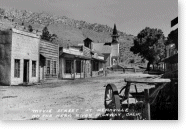 During the golden age of B-Westerns in the 1930s and 1940s, many famous Hollywood stars visited Kernville including Yakima Canutt, Tom Tyler, Harry Carey, Ken Maynard, John Wayne, George Hayes, Bob Steele, William "Hoppy" Boyd, Buck Jones, Hoot Gibson, Gene Autry, Smiley Burnette, Tex Ritter, Roy Rogers, Richard Dix, Tim Holt, Yvonne De Carlo, Humphrey Bogart,
William Elliott, and Audie Murphy.
During the golden age of B-Westerns in the 1930s and 1940s, many famous Hollywood stars visited Kernville including Yakima Canutt, Tom Tyler, Harry Carey, Ken Maynard, John Wayne, George Hayes, Bob Steele, William "Hoppy" Boyd, Buck Jones, Hoot Gibson, Gene Autry, Smiley Burnette, Tex Ritter, Roy Rogers, Richard Dix, Tim Holt, Yvonne De Carlo, Humphrey Bogart,
William Elliott, and Audie Murphy.
 Film production companies rented wagons and animal stock from local area cowboys who were given the opportunity to act or appear as extras in the movies. Many of the Kern River Valley's historical buildings, ghost towns, farms, ranches, cemeteries, and general stores have appeared on the screen. In the early 1930s, Nat Levine's serial factory, Mascot Pictures, took advantage of this locale as a backdrop for a series of Western cliffhangers including The Phantom of the West (1931), The Vanishing Legion (1931), The Lightning Warrior (1931), and The Last of the Mohicans (1932). Shortly thereafter, small neighborhood theatergoers would see Kernville's rolling landscape and rocky ridges with increasing frequency, especially in a number of B-Westerns starring a relative newcomer, John Wayne.
Film production companies rented wagons and animal stock from local area cowboys who were given the opportunity to act or appear as extras in the movies. Many of the Kern River Valley's historical buildings, ghost towns, farms, ranches, cemeteries, and general stores have appeared on the screen. In the early 1930s, Nat Levine's serial factory, Mascot Pictures, took advantage of this locale as a backdrop for a series of Western cliffhangers including The Phantom of the West (1931), The Vanishing Legion (1931), The Lightning Warrior (1931), and The Last of the Mohicans (1932). Shortly thereafter, small neighborhood theatergoers would see Kernville's rolling landscape and rocky ridges with increasing frequency, especially in a number of B-Westerns starring a relative newcomer, John Wayne.
The unsuccessful launching of Wayne as a leading man in Raoul Walsh's Big Trail (1930) for Fox Pictures relegated him to supporting roles with such stars as Buck Jones and Tim McCoy at Columbia Pictures.
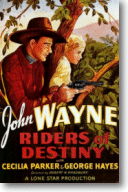 After concluding a short series of six low-budget Westerns at Warner Brothers and three action serials for Mascot, Wayne was added to the poverty row line-up of Trem Carr's Monogram Pictures. Under Paul Malvern's Lone Star Production banner and Monogram distribution, Wayne starred in sixteen (16) oaters (from late 1933 to mid-1935), with at least nine of these being filmed in Kernville: Riders of Destiny (1933), Sagebrush Trail (1933), The Lucky Texan (1934), West of the Divide (1934), Blue Steel (1934), The Star Packer (1934), The Lawless Frontier (1934), The Desert Trail (1935), and Paradise Canyon (1935). Many of these films were directed by Robert N. Bradbury and also starred George Hayes. Kernville's screen presence in the Lone Star productions was, for
After concluding a short series of six low-budget Westerns at Warner Brothers and three action serials for Mascot, Wayne was added to the poverty row line-up of Trem Carr's Monogram Pictures. Under Paul Malvern's Lone Star Production banner and Monogram distribution, Wayne starred in sixteen (16) oaters (from late 1933 to mid-1935), with at least nine of these being filmed in Kernville: Riders of Destiny (1933), Sagebrush Trail (1933), The Lucky Texan (1934), West of the Divide (1934), Blue Steel (1934), The Star Packer (1934), The Lawless Frontier (1934), The Desert Trail (1935), and Paradise Canyon (1935). Many of these films were directed by Robert N. Bradbury and also starred George Hayes. Kernville's screen presence in the Lone Star productions was, for
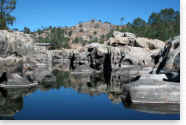 the most part, limited to scenic countryside used in chase sequences. Most of these sequences also included a climactic chase which typically ended with the horse and rider or stagecoach going over a cliff and falling into a river below. With some variation from movie to movie, the primary jump location was a lagoon in the Lower Kern River (portion that flows out of Lake Isabella) just below the earthen dam. Filmed in long shots, these stunts were performed by stuntman Yakima Canutt. Canutt also often starred as a henchman in many of these films, and frequently doubled for John Wayne, as well. The recurring western town that appeared in these films was not Kernville's Movie Street, however; it was the Trem Carr Ranch, which at the time was located on Placerita Canyon Road in Newhall.
the most part, limited to scenic countryside used in chase sequences. Most of these sequences also included a climactic chase which typically ended with the horse and rider or stagecoach going over a cliff and falling into a river below. With some variation from movie to movie, the primary jump location was a lagoon in the Lower Kern River (portion that flows out of Lake Isabella) just below the earthen dam. Filmed in long shots, these stunts were performed by stuntman Yakima Canutt. Canutt also often starred as a henchman in many of these films, and frequently doubled for John Wayne, as well. The recurring western town that appeared in these films was not Kernville's Movie Street, however; it was the Trem Carr Ranch, which at the time was located on Placerita Canyon Road in Newhall.
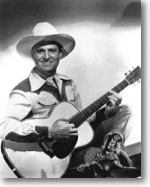 In 1935, Republic Pictures was formed by the merger of Herbert Yates' Consolidated Film, Trem Carr and W. Ray Johnston's Monogram, Paul Malvern's Lone Star, Nat Levine's Mascot Pictures, and M.H. Hoffman's Liberty Films. Although under a different banner, the Wayne and Malvern collaboration continued for one extra year, which resulted in eight additional and
higher quality B-Westerns. One of these, The New Frontier (1935), was filmed in Kernville. The creation of Republic Pictures also resulted in the acquisition of Gene Autry from Mascot Pictures, who was initially billed as "The Screen's New Singing Cowboy Star", and later "America's Singing Cowboy". With the increasing popularity of Autry, it is no surprise that Republic's best roles and story material went to their newly acquired "Singing Cowboy". Several of Autry's early films were filmed in Kernville including The Sagebrush Troubadour (1935), The Singing Vagabond (1935), Yodelin' Kid from Pine Ridge (1937), and Public Cowboy No. 1 (1937). In addition, Republic Pictures' serial directorial team of John English and William Witney filmed portions of their second serial, The Lone Ranger (1938), and its sequel,
The Lone Ranger Rides Again (1939), in this area.
In 1935, Republic Pictures was formed by the merger of Herbert Yates' Consolidated Film, Trem Carr and W. Ray Johnston's Monogram, Paul Malvern's Lone Star, Nat Levine's Mascot Pictures, and M.H. Hoffman's Liberty Films. Although under a different banner, the Wayne and Malvern collaboration continued for one extra year, which resulted in eight additional and
higher quality B-Westerns. One of these, The New Frontier (1935), was filmed in Kernville. The creation of Republic Pictures also resulted in the acquisition of Gene Autry from Mascot Pictures, who was initially billed as "The Screen's New Singing Cowboy Star", and later "America's Singing Cowboy". With the increasing popularity of Autry, it is no surprise that Republic's best roles and story material went to their newly acquired "Singing Cowboy". Several of Autry's early films were filmed in Kernville including The Sagebrush Troubadour (1935), The Singing Vagabond (1935), Yodelin' Kid from Pine Ridge (1937), and Public Cowboy No. 1 (1937). In addition, Republic Pictures' serial directorial team of John English and William Witney filmed portions of their second serial, The Lone Ranger (1938), and its sequel,
The Lone Ranger Rides Again (1939), in this area.
Throughout the 1930s, Republic Pictures was one of several motion picture studios to use Kernville as a backdrop for their films. These other studios included Supreme Pictures for Western Justice (1934) and Kid Courageous (1935) starring Bob Steele; Universal Pictures for Outlawed Guns (1935) and Sudden Bill Dorn
(1937) starring Buck Jones, and Desperate Trails (1939) starring Johnny Mack Brown; RKO Radio Pictures for Powdersmoke Range (1935) starring Harry Carey,
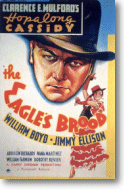 and for Park Avenue Logger (1937) starring George O'Brien; Columbia Pictures for Avenging Waters (1936) and Heroes of the Range (1936) starring Ken Maynard, and The Overland Express (1938) starring Buck Jones; Grand National Pictures for Frontier Justice (1936) starring Hoot Gibson, and Tex Rides with the Boy Scouts (1937)
starring Tex Ritter; and Ambassador Pictures for Young Dynamite (1937) starring Frankie Darro. Kernville also was used on-location for two Universal Pictures' 15-chapter serials: The Oregon Trail (1939) directed by Ford Beebe and Saul A. Goodkind, and Riders of Death Valley (1941) directed by Ford Beebe and Ray Taylor. Although most studios only utilized Kernville for a few of their celluloid flicks, from 1935 to 1941 Paramount Pictures filmed many of their Hopalong Cassidy movies there. Produced by Harry "Pop" Sherman and starring William Boyd, along with an array of changing sidekicks, titles filmed at Kernville include: The Eagle's Brood (1935), Heart of the West (1936), Call of the Prairie (1936), Three on the Trail (1936), Trail Dust (1936), Hills of Old Wyoming (1937), Rustler's Valley (1937), Partners of the Plains (1938), Heart of Arizona (1938), The Frontiersmen (1938), Sunset Trail (1939), Silver on the Sage (1939), The Showdown (1940), Hidden Gold (1940), Stagecoach War (1940), Doomed Caravan (1941), and Twilight on the Trail (1941).
and for Park Avenue Logger (1937) starring George O'Brien; Columbia Pictures for Avenging Waters (1936) and Heroes of the Range (1936) starring Ken Maynard, and The Overland Express (1938) starring Buck Jones; Grand National Pictures for Frontier Justice (1936) starring Hoot Gibson, and Tex Rides with the Boy Scouts (1937)
starring Tex Ritter; and Ambassador Pictures for Young Dynamite (1937) starring Frankie Darro. Kernville also was used on-location for two Universal Pictures' 15-chapter serials: The Oregon Trail (1939) directed by Ford Beebe and Saul A. Goodkind, and Riders of Death Valley (1941) directed by Ford Beebe and Ray Taylor. Although most studios only utilized Kernville for a few of their celluloid flicks, from 1935 to 1941 Paramount Pictures filmed many of their Hopalong Cassidy movies there. Produced by Harry "Pop" Sherman and starring William Boyd, along with an array of changing sidekicks, titles filmed at Kernville include: The Eagle's Brood (1935), Heart of the West (1936), Call of the Prairie (1936), Three on the Trail (1936), Trail Dust (1936), Hills of Old Wyoming (1937), Rustler's Valley (1937), Partners of the Plains (1938), Heart of Arizona (1938), The Frontiersmen (1938), Sunset Trail (1939), Silver on the Sage (1939), The Showdown (1940), Hidden Gold (1940), Stagecoach War (1940), Doomed Caravan (1941), and Twilight on the Trail (1941).
During the early 1940s, Paramount Pictures sold off some of its productions to United Artists. Included in this sale was "Pop" Sherman's Hopalong Cassidy series, which United Artists continued to distribute for a short time. From mid-1944 to the end of 1946, however, Hopalong Cassidy was off the screen. In the meantime, William Boyd sold off much of his personal
 property in order to buy the rights to the "Hoppy" character, as well as to all of the prior Hopalong films. Boyd formed Hopalong Cassidy Productions and resurrected the Hoppy series for an additional twelve cinematic adventures, which coincidently would continue to be distributed through United Artists. As were the earlier Hopalong films, several later entries (produced by either United Artists or Hopalong Cassidy Productions) were filmed in Kernville, including Undercover Man (1942), Hoppy Serves a Writ (1943), Border Patrol (1943), Texas Masquerade (1944), and Fool's Gold (1947). While the United Artists films remain comparatively good, they are not equivalent in quality to the earlier Paramount releases. Furthermore, the final group of Cassidy Westerns is not on par with the earlier films. Regardless of whether they were produced by Paramount, United Artists, or Hopalong Cassidy Productions, however, the Hoppy films included both Kernville's Movie Street, as well as its scenic landscape for background action.
property in order to buy the rights to the "Hoppy" character, as well as to all of the prior Hopalong films. Boyd formed Hopalong Cassidy Productions and resurrected the Hoppy series for an additional twelve cinematic adventures, which coincidently would continue to be distributed through United Artists. As were the earlier Hopalong films, several later entries (produced by either United Artists or Hopalong Cassidy Productions) were filmed in Kernville, including Undercover Man (1942), Hoppy Serves a Writ (1943), Border Patrol (1943), Texas Masquerade (1944), and Fool's Gold (1947). While the United Artists films remain comparatively good, they are not equivalent in quality to the earlier Paramount releases. Furthermore, the final group of Cassidy Westerns is not on par with the earlier films. Regardless of whether they were produced by Paramount, United Artists, or Hopalong Cassidy Productions, however, the Hoppy films included both Kernville's Movie Street, as well as its scenic landscape for background action.
No discussion about film locations, especially those used for Westerns, would be complete without mentioning at least a few of the films starring the King of the Cowboys, Roy Rogers. Ever since he appeared in Gene Autry's The Big Show (1936) as an unaccredited guitarist in the Sons of the Pioneers, Republic Pictures kept their eye on Leonard Slye - who in a short 18 months would be given his first starring vehicle as Roy Rogers. The rest is history! Soon, Rogers would be on location in Kernville filming such movies as Come On, Rangers (1938), Ridin' Down the Canyon (1942), Idaho (1943), Silver Spurs (1943), Roll On Texas Moon (1946), and On the Old Spanish Trail (1948).
Up to now, the discussion regarding Kernville as a location site has included several silent films, a few serials, and a whole host of B-Westerns, with the majority featuring John Wayne, Gene Autry, William Boyd, and Roy Rogers. There were, however, a number of A-Westerns from a variety of studios that utilized Kernville in their productions. Titles in this category include Paramount Pictures' Thunder Trail (1937) starring Gilbert Roland, Wells Fargo (1937) starring Joel McCrea, The Texans (1938) starring Randolph Scott, and Cherokee Strip (1940) starring Richard Dix; Metro-Goldwyn-Mayer Pictures' The Man from Dakota (1940) starring Wallace Beery; United Artists' Stagecoach (1939) starring John Wayne, and American Empire (1942) and Buckskin Frontier (1943) starring Richard Dix; Universal Pictures' Trail of the Vigilantes (1940) starring Franchot Tone, and Frontier Gal (1945) starring Yvonne De Carlo; Republic Pictures' Wyoming (1947) starring William Elliott; Universal International Pictures' The Michigan Kid (1947) starring Jon Hall, and Drums Across the River (1954) starring Audie Murphy; and Warner Bros. Pictures' The Treasure of the Sierra Madre (1948) starring Humphrey Bogart, and The Burning Hills (1956) starring Tab Hunter. With the waning popularity of Westerns during the 1960s and 1970s, the number of films produced in the Kernville area decreased dramatically to a mere few, which included Metro-Goldwyn-Mayer Pictures' Cattle King (1963) starring Robert Taylor; United Artists' The Defiant Ones (1958) starring Tony Curtis, and It's a Mad Mad Mad Mad World (1963) starring Spencer Tracy and a host of many many many many other stars; New World Pictures' Angels Die Hard (1970) starring Tom Baker; and Universal Pictures' Showdown (1973) starring Rock Hudson. Most recently, the Kern River has been used in Universal Pictures' Jurassic Park III (2001) starring Sam Neill. Over the years, hundreds of major motion pictures, television programs, commercials, and music videos have been filmed at the many photogenic locations in the great outdoors of Kern Valley.
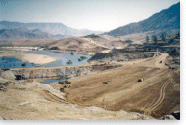 Coincidental to the construction of hydroelectric power projects on the Kern River, the U.S. Army Corps of Engineers had also considered building a dam across the river as early as 1913. When a decision was finally reached in 1944, Kern Valley residents were astounded to learn that the entire towns of Kernville and Isabella would be under water upon completion of the dam. Construction on the man-made reservoir was started in March of 1948 and was completed in 1953. In 1951, some of the residents of old Kernville moved north to what was the Burlando Ranch and started a new Kernville; others moved south and west to the Irvin Wofford Ranch and created Wofford Heights. Residents of Isabella moved south to what was known as Hot Springs Valley and established the town of Lake Isabella.
Coincidental to the construction of hydroelectric power projects on the Kern River, the U.S. Army Corps of Engineers had also considered building a dam across the river as early as 1913. When a decision was finally reached in 1944, Kern Valley residents were astounded to learn that the entire towns of Kernville and Isabella would be under water upon completion of the dam. Construction on the man-made reservoir was started in March of 1948 and was completed in 1953. In 1951, some of the residents of old Kernville moved north to what was the Burlando Ranch and started a new Kernville; others moved south and west to the Irvin Wofford Ranch and created Wofford Heights. Residents of Isabella moved south to what was known as Hot Springs Valley and established the town of Lake Isabella.
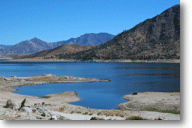 This name was chosen by Steven Barton in honor of the 19th century Queen Isabella of Spain because he believed the Spanish Queen's contribution to the New World had been overlooked. Created for flood control, agricultural improvement, hydroelectric power, and to provide water to Bakersfield, Lake Isabella is one of the largest man-made fresh water reservoirs in the world. It contains approximately 11,200 acres of surface water and is surrounded by 38.6 miles of shoreline. Lake Isabella is located in the dry desert environment at the tail end of the Sequoia National Forest. In the late 1970s, a new freeway opened bypassing the upper portion of the old highway along the Kern River. The south portion of the road along the Kern River has been upgraded many times and continues to be one of the most scenic highways in California.
This name was chosen by Steven Barton in honor of the 19th century Queen Isabella of Spain because he believed the Spanish Queen's contribution to the New World had been overlooked. Created for flood control, agricultural improvement, hydroelectric power, and to provide water to Bakersfield, Lake Isabella is one of the largest man-made fresh water reservoirs in the world. It contains approximately 11,200 acres of surface water and is surrounded by 38.6 miles of shoreline. Lake Isabella is located in the dry desert environment at the tail end of the Sequoia National Forest. In the late 1970s, a new freeway opened bypassing the upper portion of the old highway along the Kern River. The south portion of the road along the Kern River has been upgraded many times and continues to be one of the most scenic highways in California.
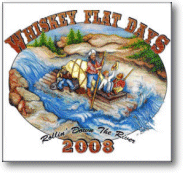 With approximately 1,800 residents, the Western-motif village of Kernville annually hosts a number of popular events. Whiskey Flat Days is one of California's oldest Cowboy and Miner Western Festivals and is held each Presidents' Day weekend to celebrate the traditions of 1860s-era California; "Kickin' Back in Kernville" Road Run is a juried car rally that attracts pre-1975 vintage automobiles from surrounding states and features cruising around Lake Isabella; and Kernville Stampede, a professional rodeo held at the John E. McNally Arena,
With approximately 1,800 residents, the Western-motif village of Kernville annually hosts a number of popular events. Whiskey Flat Days is one of California's oldest Cowboy and Miner Western Festivals and is held each Presidents' Day weekend to celebrate the traditions of 1860s-era California; "Kickin' Back in Kernville" Road Run is a juried car rally that attracts pre-1975 vintage automobiles from surrounding states and features cruising around Lake Isabella; and Kernville Stampede, a professional rodeo held at the John E. McNally Arena,
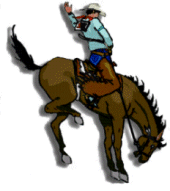 attracts cowboy and cowgirl participants from around the country in a wide variety of rodeo events, including team roping, steer wrestling, bronco busting, and barrel racing. The Kern Valley Museum, which sponsors an annual History Days Celebration, contains exceptional displays featuring Native American artifacts, pioneer memorabilia, gold mining, lumbering, and farming and ranching equipment. The Museum also houses a film history section that features some of the most famous Hollywood Westerns that were shot in the Kern River Valley during the 1930s-1950s. Many of these films are available for viewing from the Museum’s video library. An art gallery exhibits works of local artists, which are changed monthly and available for purchase. The nearby Kern River Fish Hatchery contains a Natural History and Fishing Museum, as well as a number of exhibits on the native California golden trout and other fish.
attracts cowboy and cowgirl participants from around the country in a wide variety of rodeo events, including team roping, steer wrestling, bronco busting, and barrel racing. The Kern Valley Museum, which sponsors an annual History Days Celebration, contains exceptional displays featuring Native American artifacts, pioneer memorabilia, gold mining, lumbering, and farming and ranching equipment. The Museum also houses a film history section that features some of the most famous Hollywood Westerns that were shot in the Kern River Valley during the 1930s-1950s. Many of these films are available for viewing from the Museum’s video library. An art gallery exhibits works of local artists, which are changed monthly and available for purchase. The nearby Kern River Fish Hatchery contains a Natural History and Fishing Museum, as well as a number of exhibits on the native California golden trout and other fish.
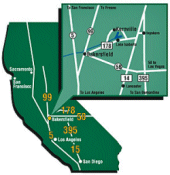 Historically, the Kern River Valley is a microcosm of the American West. Gold rush fever, legendary outlaws and gunslingers, and the struggle between cattlemen and sheep herders all are part of the area’s past. Today, the Valley is a welcome reprieve from the frenzied life of other California cities and is one of the few Southern California areas that experience all four seasons. Residents and visitors can enjoy winter snowfalls, beautiful spring flora, sunny summer days, and the vibrant red, orange and yellow colors of autumn. The Kern River Valley offers many outdoor activities including boating, fly fishing, whitewater rafting, kayaking, jet skiing, windsurfing, camping, hiking, horseback riding, mountain biking, and rock climbing, as well as a variety of lodging and resort options. Located approximately three hours north of Los Angeles and one hour northeast of Bakersfield, Kernville is between Bakersfield and Ridgecrest along Highway 155 on the banks of the Kern River, 12.5 miles north of the town of Lake Isabella in the southern Sierra Mountains.
Historically, the Kern River Valley is a microcosm of the American West. Gold rush fever, legendary outlaws and gunslingers, and the struggle between cattlemen and sheep herders all are part of the area’s past. Today, the Valley is a welcome reprieve from the frenzied life of other California cities and is one of the few Southern California areas that experience all four seasons. Residents and visitors can enjoy winter snowfalls, beautiful spring flora, sunny summer days, and the vibrant red, orange and yellow colors of autumn. The Kern River Valley offers many outdoor activities including boating, fly fishing, whitewater rafting, kayaking, jet skiing, windsurfing, camping, hiking, horseback riding, mountain biking, and rock climbing, as well as a variety of lodging and resort options. Located approximately three hours north of Los Angeles and one hour northeast of Bakersfield, Kernville is between Bakersfield and Ridgecrest along Highway 155 on the banks of the Kern River, 12.5 miles north of the town of Lake Isabella in the southern Sierra Mountains.